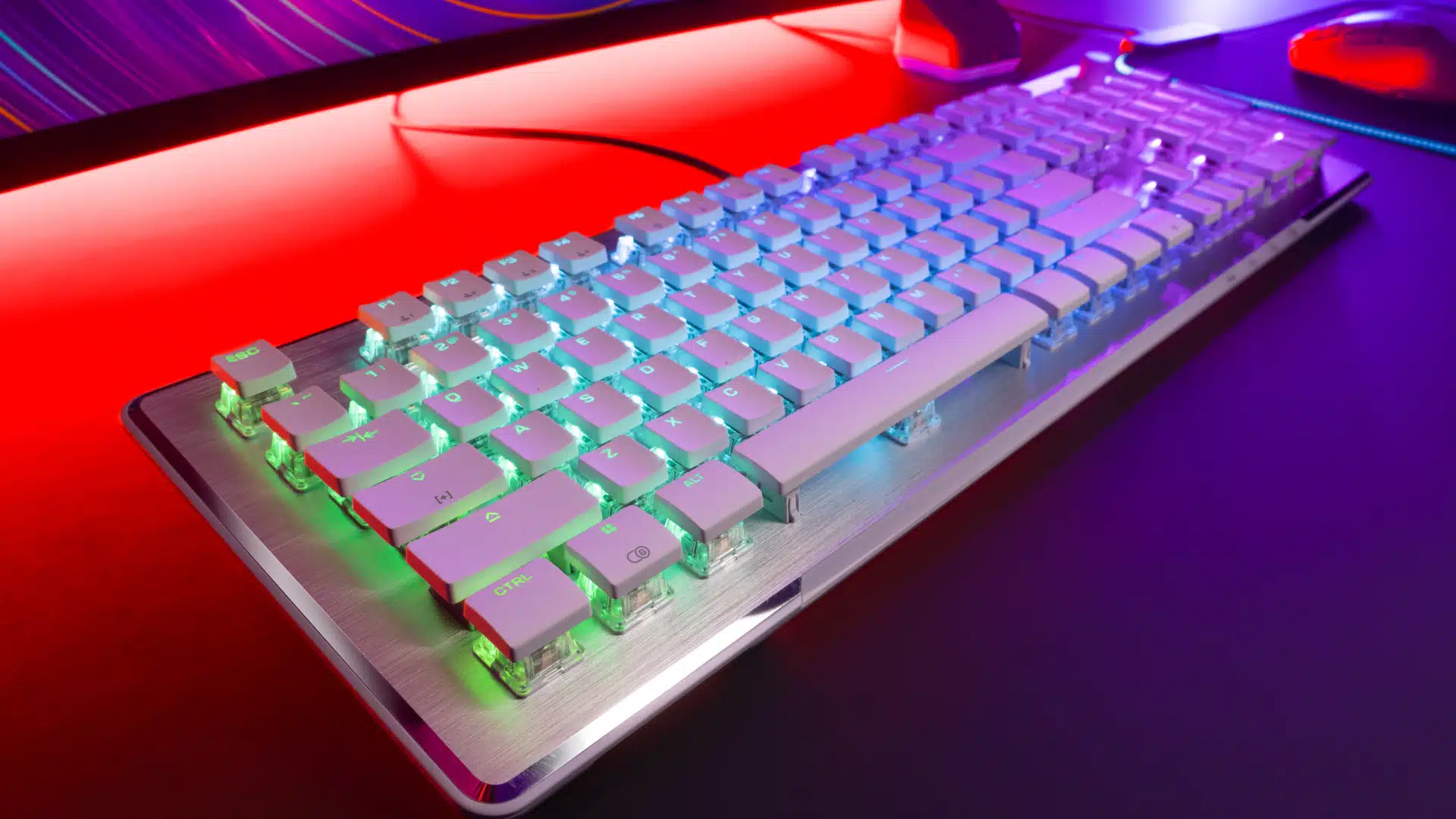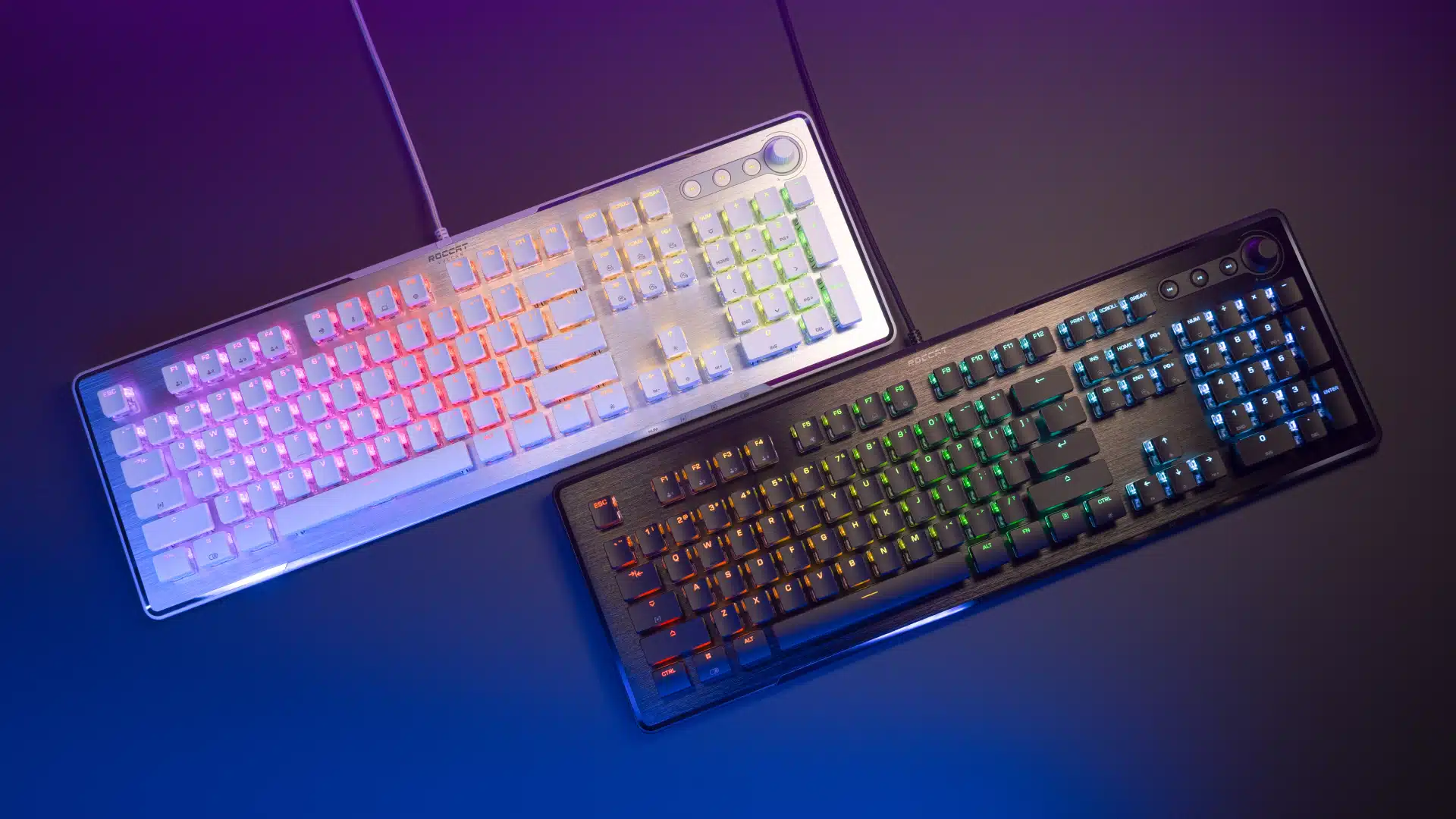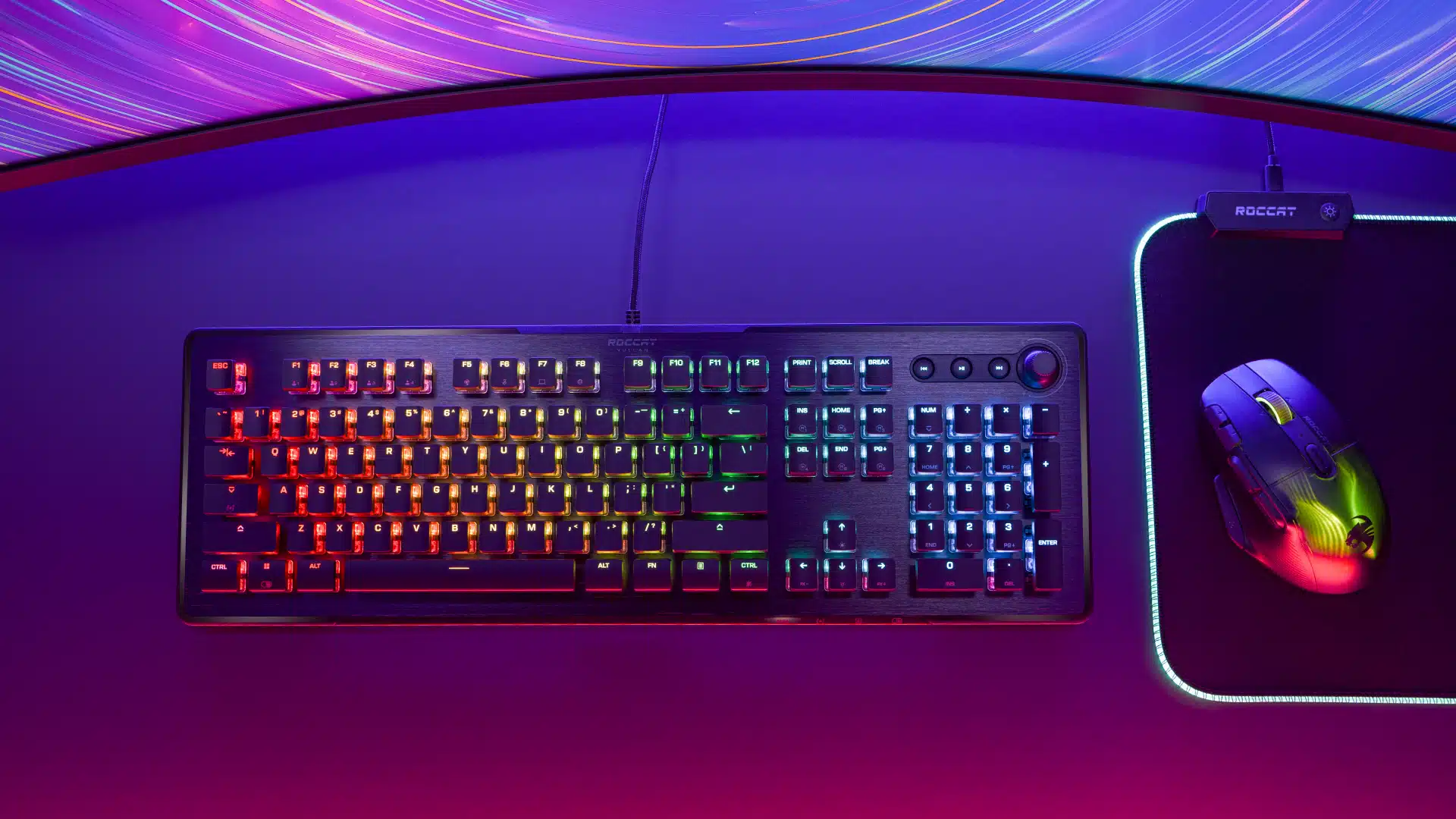After years of waiting, ROCCAT is finally releasing a new mechanical keyboard! Marketed as the successor to the Vulcan 120 Series line, the Vulcan II promises an exceptional experience while pushing the boundaries of what a mechanical keyboard can do. Lucky for you, we’ve been hands-on with the new keyboard to see if ROCCAT can deliver. The short and quick answer: Yes, yes, they can.
The King of Clicks
From a design perspective, the Vulcan II mechanical keyboard shares a similar, if not exact, design as the other Vulcan II series line keyboards. It comes in two colors, white and black, and has a gorgeous durable aluminum top plate. It has RGB lighting, which is fully customizable via the ROCCAT Swarm application. It’s a full-sized keyboard, so you’re getting the full set of keys, plus a media center that has a volume control knob, as well as a play/pause, fast forward, and rewind.

As I said, the Vulcan II is designed similarly to other Vulcan keyboards, which isn’t a complaint, as this design has been well received, not only by me, but by many in the gaming community. It’s a stunning design with little to no flaws outside the fact that my cat loves to sleep on them. However, where the Vulcan II differs from the Vulcan II Max, Vulcan II Mini, and, well, any of the recent ROCCAT keyboards is that it opts for mechanical switches rather than optical.
That means that ROCCAT is going old school, making a hard point of contact with the keys in the Vulcan II. Although optical switches have their benefits, there’s no denying that mechanical keyboards are still a favorite amongst the PC community, and for good reasons. They’re quiet and have this distinct feeling from the presses that are ever so satisfying compared to their optical counterparts.
The Vulcan II mechanical keyboard doesn’t disappoint there either, as its pre-lubricated keys are surprisingly quiet, even when stacked against other mechanical boards.
And as mentioned, mechanical keyboards have a bit more of a satisfying feel to their presses over optical. Even when there’s a bit of tactile embedded in some of the optical switches, there’s no beating that tactile response you get from a mechanical keyboard. The Vulcan II It’s a hard feeling to describe, but it’s almost as if you get the right amount of feedback from them without a press feeling too cheap or hollow.

As for the performance of the Vulcan II mechanical keyboard, it seems to be almost on par with its optical switch counterpart. Using some latency test tools, I found that the optical switches registered on average a few milliseconds quicker than the Vulcan II. That’s mainly because mechanical keys require hard contact, whereas optical don’t, but even then, I’d hardly say the differences were drastic, certainly not enough to notice during real-time use.
Optical switches still offer an edge regarding competitiveness due to their low latency. Still, we’ve also come a long way since their introduction, so it’s great seeing ROCCAT further improve and push the boundaries of these mechanical switches to try and match their optical counterparts.
However, compared to other mechanical keyboards, the Vulcan II’s Titan II Mechanical switches easily take the spot as one of the fastest and most responsive mechanical switches I’ve seen in a mechanical keyboard. They’ll definitely give you a competitive edge over other boards, as a head-to-head button press will undoubtedly go to the Vulcan II due to how fast the signal is read after actuation.
ROCCAT outlines that the keys can last 80 million clicks for key durability versus their optical switches, which can handle 100 million clicks. That’s a lot of clicks for either switch type, but in terms of what that means to you, the reader, those numbers are probably well past even your own life expectancy unless you plan on passing down this keyboard like some weird family heirloom. You’d probably upgrade to a newer and better board by then, or the board would likely break elsewhere, but at the very least, you can rest easy knowing that the keys have been built to last rather than break like many electronics nowadays.

To anyone wondering about key “stickiness,” after almost three weeks of using the Vulcan II for about eight hours daily for both writing and gaming, I can’t say I’ve noticed any, as it still feels like it does the day I first used it. That may not mean much now, but I’ve also used the Vulcan II Max daily for the last year, and it, too, feels like it’s as good as new. Now if only my cats would stop sleeping on top of it, it’d still look like it just came out of the box.
The Vulcan II also ships with a detachable palm rest. It’s a hard, smoothly matted plastic that snaps right in at the bottom of the board. If you don’t like it, you don’t have to use it. Personally, I’d prefer a rubberized one, as I find those to have a bit of cushioning. At the rate ROCCAT releases these keyboards, I would have loved to see the palm rests get a universal design that makes them compatible with other shared family ROCCAT keyboards. Options are nice to have.
Speaking of “options,” the keycaps continue to use a cross-mounted design, meaning if you wanted to throw your keys on this board, you should be able to, as it’s compatible with most third-party keycaps. Transparent keycaps really bring out the RGB lighting.

Sadly the Vulcan II mechanical isn’t equipped with dual-LED like the ones in the Vulcan II Mini and Vulcan II Max. You can still program multiple functions on keys; it just lacks the dual LED to indicate which function is activated. It would have been great to see that here, though we can understand if it’s viewed more as a niche.
Verdict
There are only two things at this point that I can see making the Vulcan II mechanical keyboard a better keyboard than it already is. One is having a full wireless option available, which may not be too far, considering ROCCAT just launched its first wireless keyboard today, the Vulcan II Mini Air (our review.) The second I’d like to see, and not just for the Vulcan II, but for all future keyboards from all manufacturers, is USB-C connectivity. The ports are known for their speeds, which come in handy for powering hubs and such, but keyboards benefit from their sturdier and more durable connections, their universal orientation of being able to plug in any direction, and their ability to feed more power, which can benefit RGB lighting. Also, I’m tired of giving Apple my money and hate that I have to use an adaptor on their MacBooks now. USB-C is becoming more and more standardized in the industry.
Heck, the last two motherboards I bought for my PCs have USB-C now on them, and even the two cases for each had one. It’ll be fantastic future-proofing down the road, but USB-B is still very much the standard today, so we’re sure we’ll see a USB-C keyboard from ROCCAT in the near future.
But the future is, well, the future, and we’re here to talk about today, a day which, to me, marks the launch of one of the greatest mechanical keyboards ever designed. I have nothing but high praise for the ROCCAT Vulcan II mechanical keyboard. It’s what many would want out of a keyboard. It’s superbly fast, responsive, sleek, gorgeous, and decently priced, all while maintaining that satisfying feeling that only a mechanical keyboard can provide.
And those who have been with the ROCCAT family for some time now and have owned the Vulcan 120 Aimo know that the Vulcan II is worthy of being called its successor.
Where to buy the Roccat Vulcan II Keyboard WIth Mechanical Switches?
- Roccat Vulcan II With Mechanical Switches – MSRP $149.99 – Launches July 19
General Specifications
- Form Factor: Full Size
- Connectivity: USB-A Wired
- Cable: 1.8m braided USB 2.0
- Switch lifecycle: Tested to 80 million
- Polling Rate: 1000 Hz
- On-board memory: 4MB
- Profile On-board: 4
- RGB: RGB per-key illumination with 16.8m colors
- Keyboard Rollover: Full Key (NKRO) with 100% Anti-Ghosting
- Processor: 32-bit ARM Cortex M0
- Software: SWARM
- Adjustable height: Yes
Score: 9.5/10
Pros:
- Gorgeous, sleek, and premium design.
- Perfect “feel” from key presses.
- New Titan II mechanical switches deliver low latency.
- Cross-mounted design that supports most keycaps.
- Well-applied RGB lighting.
Cons:
- Not a fan of the hard plastic palm rest, but it’s optional.
The publisher provided hardware for review purposes. Equipment tested on a desktop PC. You can read SP1st and MP1st’s review and scoring policy right here.
